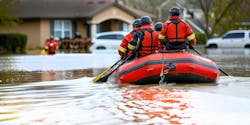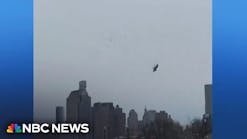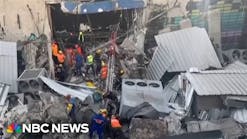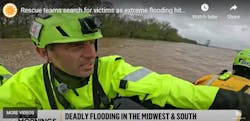April 16, 1947, started out like any other spring day along the Gulf Coast in the town of Texas City, TX, population 16,000. Longshoremen busily loaded ships at the Port of Texas City and other townspeople went about their daily activities. The cargo ship Grandcamp was at the port taking on a load of ammonium nitrate fertilizer to be shipped to Europe as part of the rebuilding process following World War II.
Initially, the Grandcamp was scheduled to load the ammonium nitrate cargo at the Port of Houston. However, ammonium nitrate is not permitted to be handled at Houston, so transported to Texas City by rail from Nebraska and Iowa, the 32.5% ammonium nitrate fertilizer was placed into the hold of the ship along with a cargo of small-arms ammunition. Approximately 17 million pounds of ammonium nitrate was loaded onto the ship. Also in the harbor that day was the High Flyer, berthed approximately 600 feet from the Grandcamp on the same dock and loaded with 2 million pounds of ammonium nitrate and 4 million pounds of sulfur. By comparison, the bomb used in the bombing of the Murrah Federal Building in Oklahoma City in 1995 contained 5,000 pounds of ammonium nitrate and the bomb used at the World Trade Center in New York City in 1993 contained 1,500 pounds of ammonium nitrate.
Ammonium nitrate at a concentration of 32.5% is classified by the U.S. Department of Transportation (DOT) as an oxidizer and intended primarily as a fertilizer for agricultural and home use. Ammonium nitrate is also used as an oxidizer in the manufacturing of explosives. The ammonium nitrate that was loaded on the two ships at the Port of Texas City was coated with paraffin (a hydrocarbon product) and other chemicals to prevent caking of the material. Adding paraffin to the ammonium nitrate oxidizer is like combining fuel and oxygen, fulfilling two requirements of the fire triangle. All that is missing is heat. Because ammonium nitrate is also an oxidizer, under certain conditions it can become explosive. For an explosion to occur involving ammonium nitrate, confinement is necessary for the fuel and oxidizer before the heat is applied. As longshoremen were loading the ammonium nitrate on the ship, they reported that the bags were warm. This could have been caused by an exothermic (heat-releasing) chemical reaction going on within the bags. A chemical process resulting in spontaneous combustion can occur with chemical oxidizers at elevated temperatures.
At around 8:10 A.M., a fire was reported deep in Cargo Hold No. 4 of the Grandcamp, toward the rear of the ship on the lower level. Two fire extinguishers and a gallon jug of drinking water were applied to the fire area by the ship's crew with little effect. The captain of the ship ordered the burning hold sealed and steam injected into it. This was a common method of shipboard firefighting at that time. This confinement and injection of steam is likely to have resulted in the elevation of the temperature of the ammonium nitrate and the explosion that occurred.
Texas City's volunteer fire department responded to the initial report of fire with its four fire engines led by Chief Henry J. Baumgartner. It is unknown whether the fire department had any knowledge of the dangers of fires involving ammonium nitrate or potential explosives. A fireboat from Galveston was requested at about the same time by the ship's captain. Twenty-seven of the Texas City department's 28 volunteers answered the call along with the Republic Oil Refining Company firefighting team. The firefighters set up their hose streams along the dock and applied water into the burning hold of the Grandcamp. Smoke poured from the hold, followed by flames at around 9 A.M. The unusual color of the smoke caught the attention of many people. Some described it as a peach color, some called it reddish orange.
At 9:12 A.M., an explosion occurred in the hold. In an instant, all 27 volunteer firefighters were killed. Some of their bodies were disintegrated by the heat and pressure of the explosion. All that remained of their apparatus were piles of twisted metal. Texas City lost all but one of its firefighters and every piece of its apparatus in the explosion. Until the 9/11 terrorist attacks in New York City, this was the largest single loss-of-life incident experienced by any fire department in the United States.
In addition to the loss of life, there was extensive property damage. The force of the explosion - heard over 150 miles away - knocked two small airplanes out of the sky. Debris fell on homes and businesses, setting many buildings on fire. People on the streets of Galveston, 11 miles away, were knocked to the ground by the force of the blast. Chemical plants and petroleum storage facilities along the bay were set afire as well. The explosion set fire to the High Flyer, docked near the Grandcamp and also loaded with ammonium nitrate. An anchor from the Grandcamp that weighed over 3,000 pounds was propelled two miles away and created a 10-foot-deep crater. A seismologist in Denver, CO, recorded the shock waves from the explosion and thought an atomic bomb had been detonated in Texas. In Omaha, NE, the Strategic Air Command briefly elevated the United States defense condition (Defcon) believing a nuclear attack was taking place.
Following the explosion, firefighters responded to Texas City from communities across southern Texas, some from as far as 60 miles away. A lone Texas City firefighter, Fred Dowdy, who had not responded to the initial call, coordinated the mutual aid firefighters arriving in Texas City to offer assistance. Dowdy's late response likely saved his life, as he was the only member of the Texas City Fire Department who was not killed by the explosion. Eventually, more than 200 firefighters responded from as far away as Los Angeles, CA.
At approximately 1:10 A.M. the following day, the High Flyer exploded. By many accounts, the High Flyer explosion was greater than the one that occurred in the Grandcamp, but the dock area had been cleared and casualties were light in the second explosion. Additional property damage occurred from the force of the blast and more fires were set throughout Texas City. A small tidal wave created in the bay traveled over 150 feet inland.
It took almost a week to control and extinguish all of the fires caused by the two explosions, which destroyed the Grandcamp and High Flyer. The last body was removed from the debris nearly a month later. The Grandcamp and High Flyer explosions resulted in the worst industrial accident, producing the largest number of casualties, in the history of the United States.
When it was all over, more than 405 identified people were dead and more than 3,500 injured. There were also 63 people who died and could not be identified and more than 100 others were presumed dead, as their bodies were never found. Some believed that hundreds more were killed, but unaccounted for, including visiting seamen, non-census laborers and their families, and untold numbers of travelers - although some people who were as close as 70 feet from the Grandcamp when it exploded survived. Refinery infrastructure and pipelines, including about 50 oil storage tanks, were extensively damaged or destroyed from the blast pressure and resulting fires, which burned for days. A Monsanto chemical plant was heavily damaged and 143 of the civilian deaths occurred there among employees. Over 500 homes were destroyed and hundreds of others damaged, leaving over 2,000 people homeless. Property loss was listed at over $100 million. Bulk cargo-handling operations never resumed at the Port of Texas City. However, the Monsanto plant was rebuilt and back in operation within a year. The cause of the fire has never been officially determined, but it could have been caused by spontaneous combustion or, a carelessly discarded cigarette, or intentionally set.
Services for the dead who could not be unidentified were held on Sunday morning, June 22, 1947. Nineteen volunteer firefighters were listed as missing and some may have been among the unidentified buried on that morning. Even though there was little advance notice of the funerals, cars were parked 1½ miles on both sides of the highway leading to the cemetery. The crowd was estimated at 5,000. Sixty-three caskets were transported from Camp Wallace by separate hearses from 51 funeral homes representing 28 cities. It must have been a striking procession, likely one of the longest to have ever occurred in the United States. The caskets were carried by volunteer pallbearers provided by the American Legion, Veterans of Foreign Wars, labor organizations and volunteer firefighters. Each casket was decorated with flowers donated by the florist's association.
When the Texas City disaster occurred, there were no fire department hazardous materials teams or hazmat training in the United States, self-contained breathing apparatus (SCBA) were generally unheard of, no placarding and labeling system existed, and there was little government regulation of hazardous materials. Government today plays a more active role in regulation in preventing a Texas City-like disaster from happening again. Safe handling of ammonium nitrate is covered by the National Fire Protection Association (NFPA) 490 Standard, Storage and Handling of Ammonium Nitrate. Additionally, state and local agencies may have regulations for hazardous materials, including ammonium nitrate.
Besides the regulations above, the NFPA and other government agencies have established regulations and guidelines on firefighting techniques, including potential explosives fires such as those involving ammonium nitrate. Employees who are expected to fight fires are required to undergo specialized training and be properly equipped as stated in Occupational Safety and Health Administration (OSHA) 1910.156. Basically, the OSHA requirements for fighting this type of fire are to wear appropriate protective clothing to prevent contact with skin and eyes and SCBA to prevent contact with thermal decomposition products. For small fires, water spray, dry chemical, carbon dioxide or chemical foam can be effective. Water should be sprayed on fire-exposed containers to cool them and avoid explosion. Flooding amounts of water are recommended for fighting a fire involving ammonium nitrate. Cargo holds of burning ammonium nitrate should never be sealed or injected with steam. Firefighters should exercise extreme caution when fighting fires involving explosives or explosive materials. If there is any danger of explosion, firefighters should withdraw, evacuate the public and let the incident take its course.
My thanks to Texas City Fire Chief Gerald Grimm, Administrative Assistant Jane Tull and Beth Ryker Steiner, director of the Moore Memorial Public Library in Texas City, for their assistance in the preparation of this column.
TEXAS CITY FIRE DEPARTMENT PROFILE
Texas City, TX, is approximately 40 miles southeast of Houston and 11 miles northwest of Galveston on Galveston Bay just north of the entrance to the Gulf of Mexico. Currently, the population is estimated at just over 44,000. Founded in 1911 with settlements dating to the early 1800s, Texas City's development has been influenced by its location in proximity to the Gulf of Mexico and the petrochemical industry. The Port of Texas City is the eighth-largest port in the United States and the third largest in Texas, currently exceeding 78 million net tons of cargo annually.
Texas City has had a fully paid fire department since 1956. Prior to that time, fire department staffing consisted totally of volunteers until just after the Texas City Disaster of 1947. Following the disaster, the department evolved into a combination department with some career and some volunteer firefighters before becoming all career. Gerald Grimm is the present fire chief and leads a force of 60 personnel operating from three fire stations. Texas City has two front-line engine companies; one quint with a 100-foot ladder, foam tank and 2,250-gpm pump; a heavy-duty rescue-hazmat truck; a rescue truck; and a boat. Texas City Fire Department provides a first-responder EMS program and has in service a water rescue team, high-angle rescue/confined-space response unit and hazardous materials response team. The Texas City Fire Department responds to an average of 4,600 calls for assistance each year.
ROBERT BURKE, a Firehouse contributing editor, is the fire marshal for the University of Maryland-Baltimore. He is a Certified Fire Protection Specialist (CFSP), Fire Inspector II, Fire Inspector III, Fire Investigator and Hazardous Materials Specialist, and has served on state and county hazardous materials response teams. Burke is an adjunct instructor at the National Fire Academy and the Community College of Baltimore, Catonsville Campus, and the author of the textbooks Hazardous Materials Chemistry for Emergency Responders and Counter-Terrorism for Emergency Responders. He can be contacted at [email protected].
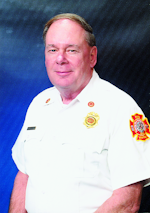
Robert Burke
Robert Burke, who is a hazardous materials and fire protection consultant and who served as a Firehouse contributing editor, is a Certified Fire Protection Specialist (CFSP), Fire Inspector II, Fire Inspector III, Fire Investigator and Hazardous Materials Specialist. He has served on state and county hazmat teams. Burke is the author of the textbooks "Hazardous Materials Chemistry for Emergency Responders," "Counter-Terrorism for Emergency Responders," "Fire Protection: Systems and Response," "Hazmat Teams Across America" and "Hazmatology: The Science of Hazardous Materials."
